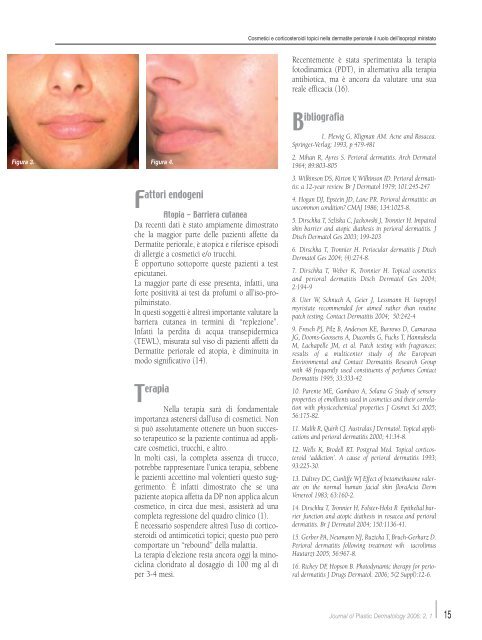Aprile Vol.2 N° 1 - 2006 - Salute per tutti
Aprile Vol.2 N° 1 - 2006 - Salute per tutti
Aprile Vol.2 N° 1 - 2006 - Salute per tutti
Create successful ePaper yourself
Turn your PDF publications into a flip-book with our unique Google optimized e-Paper software.
Figura 3.<br />
Figura 4.<br />
attori endogeni<br />
F<br />
Atopia - Barriera cutanea<br />
Da recenti dati è stato ampiamente dimostrato<br />
che la maggior parte delle pazienti affette da<br />
Dermatite <strong>per</strong>iorale, è atopica e riferisce episodi<br />
di allergie a cosmetici e/o trucchi.<br />
È opportuno sottoporre queste pazienti a test<br />
epicutanei.<br />
La maggior parte di esse presenta, infatti, una<br />
forte positività ai test da profumi o all’iso-propilmiristato.<br />
In questi soggetti è altresì importante valutare la<br />
barriera cutanea in termini di “replezione”.<br />
Infatti la <strong>per</strong>dita di acqua transepidermica<br />
(TEWL), misurata sul viso di pazienti affetti da<br />
Dermatite <strong>per</strong>iorale ed atopia, è diminuita in<br />
modo significativo (14).<br />
T erapia<br />
Nella terapia sarà di fondamentale<br />
importanza astenersi dall’uso di cosmetici. Non<br />
si può assolutamente ottenere un buon successo<br />
terapeutico se la paziente continua ad applicare<br />
cosmetici, trucchi, e altro.<br />
In molti casi, la completa assenza di trucco,<br />
potrebbe rappresentare l’unica terapia, sebbene<br />
le pazienti accettino mal volentieri questo suggerimento.<br />
È infatti dimostrato che se una<br />
paziente atopica affetta da DP non applica alcun<br />
cosmetico, in circa due mesi, assisterà ad una<br />
completa regressione del quadro clinico (1).<br />
È necessario sospendere altresì l’uso di corticosteroidi<br />
od antimicotici topici; questo può <strong>per</strong>ò<br />
comportare un “rebound” della malattia.<br />
La terapia d’elezione resta ancora oggi la minociclina<br />
cloridrato al dosaggio di 100 mg al dì<br />
<strong>per</strong> 3-4 mesi.<br />
Cosmetici e corticosteroidi topici nella dermatite <strong>per</strong>iorale il ruolo dell’isopropl miristato<br />
Recentemente è stata s<strong>per</strong>imentata la terapia<br />
fotodinamica (PDT), in alternativa alla terapia<br />
antibiotica, ma è ancora da valutare una sua<br />
reale efficacia (16).<br />
B ibliografia<br />
1. Plewig G, Kligman AM. Acne and Rosacea.<br />
Springer-Verlag; 1993, p 479-481<br />
2. Mihan R, Ayres S. Perioral dermatitis. Arch Dermatol<br />
1964; 89:803-805<br />
3. Wilkinson DS, Kirton V, Wilkinson ID. Perioral dermatitis:<br />
a 12-year review. Br J Dermatol 1979; 101:245-247<br />
4. Hogan DJ, Epstein JD, Lane PR. Perioral dermatitis: an<br />
uncommon condition? CMAJ 1986; 134:1025-8.<br />
5. Dirschka T, Szliska C, Jackowski J, Tronnier H. Impaired<br />
skin barrier and atopic diathesis in <strong>per</strong>ioral dermatitis. J<br />
Dtsch Dermatol Ges 2003; 199-203<br />
6. Dirschka T, Tronnier H. Periocular dermatitis J Dtsch<br />
Dermatol Ges 2004; (4):274-8.<br />
7. Dirschka T, Weber K, Tronnier H. Topical cosmetics<br />
and <strong>per</strong>ioral dermatitis Dtsch Dermatol Ges 2004;<br />
2:194-9<br />
8. Uter W, Schnuch A, Geier J, Lessmann H. Isopropyl<br />
myristate recommended for aimed rather than routine<br />
patch testing. Contact Dermatitis 2004; 50:242-4<br />
9. Frosch PJ, Pilz B, Andersen KE, Burrows D, Camarasa<br />
JG, Dooms-Goossens A, Ducombs G, Fuchs T, Hannuksela<br />
M, Lachapelle JM, et al. Patch testing with fragrances:<br />
results of a multicenter study of the European<br />
Environmental and Contact Dermatitis Research Group<br />
with 48 frequently used constituents of <strong>per</strong>fumes Contact<br />
Dermatitis 1995; 33:333-42<br />
10. Parente ME, Gambaro A, Solana G Study of sensory<br />
pro<strong>per</strong>ties of emollients used in cosmetics and their correlation<br />
with physicochemical pro<strong>per</strong>ties J Cosmet Sci 2005;<br />
56:175-82.<br />
11. Malik R, Quirk CJ. Australas J Dermatol. Topical applications<br />
and <strong>per</strong>ioral dermatitis 2000; 41:34-8.<br />
12. Wells K, Brodell RT. Postgrad Med. Topical corticosteroid<br />
‘addiction’. A cause of <strong>per</strong>ioral dermatitis 1993;<br />
93:225-30.<br />
13. Daltrey DC, Cunliffe WJ Effect of betamethasone valerate<br />
on the normal human facial skin floraActa Derm<br />
Venereol 1983; 63:160-2.<br />
14. Dirschka T, Tronnier H, Folster-Holst R Epithelial barrier<br />
function and atopic diathesis in rosacea and <strong>per</strong>ioral<br />
dermatitis. Br J Dermatol 2004; 150:1136-41.<br />
15. Gerber PA, Neumann NJ, Ruzicka T, Bruch-Gerharz D.<br />
Perioral dermatitis following treatment wih tacrolimus<br />
Hautarzt 2005; 56:967-8.<br />
16. Richey DF, Hopson B. Photodynamic therapy for <strong>per</strong>ioral<br />
dermatitis J Drugs Dermatol. <strong>2006</strong>; 5(2 Suppl):12-6.<br />
Journal of Plastic Dermatology <strong>2006</strong>; 2, 1<br />
15

















